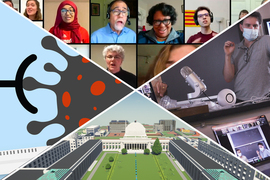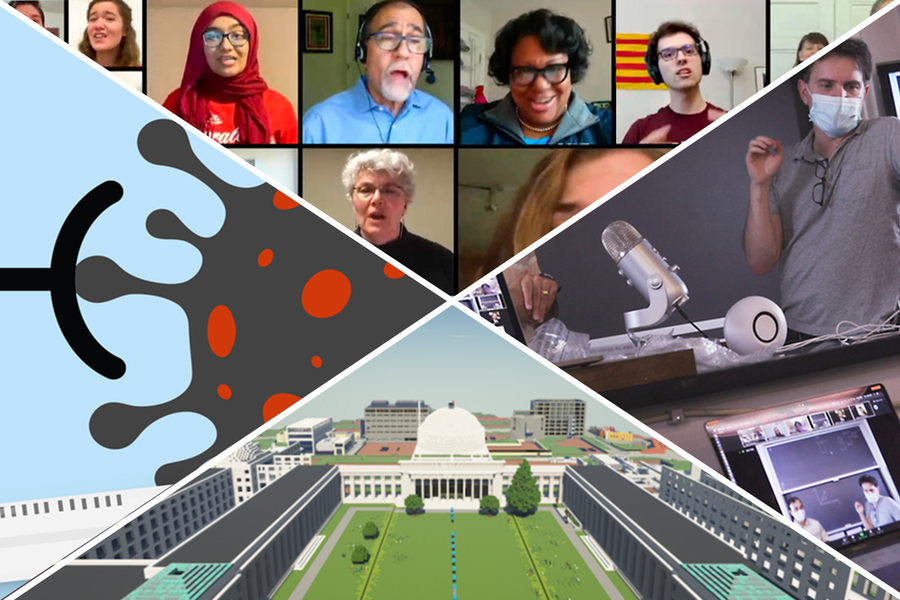The pivotal email from President L. Rafael Reif arrived in the inboxes of the MIT community on March 10, 2020. After weeks of monitoring the emerging coronavirus, it was decision time: "We have come to see that our community has a significant role to play in the concerted public health response to this regional, national and global threat,” he wrote.
The full extent of that role wasn’t yet clear as students immediately prepared to leave campus, followed by the majority of faculty and staff, to decrease the risk of spreading Covid-19. But the next 12 months would test the Institute and the world in ways previously unimagined. While rising to the challenges of remote education and keeping campus safe, MIT community members would also cope with the impacts of the pandemic in their own lives. Urgent calls for social justice and the prospect of an unstable democracy added to the turbulence.
A March 10, 2021 ceremony, MIT Reflects: Moments of Remembrance and Hope, will mark the one-year anniversary of when MIT ramped down its operations and embarked on its journey through the Covid era. The program includes music and poetry as well as prayers drawn from the diversity of the world’s spiritual and ethical traditions, followed by smaller group discussions.
Here, we take a nonexhaustive look back at some of the milestones in a year like no other.
Spring: A community leaps into action
As hospitalizations surged in the early months of the pandemic, the need for medical equipment was acute. A cross-campus team responded quickly to collect PPE from MIT labs and deliver it to frontline workers. Engineers designed disposable face shields and low-cost, open-source ventilators that could be mass-produced and widely deployed. MIT’s Rapid Innovation Dashboard filled with projects aimed at helping the people most affected by Covid-19, and by June, MIT faculty, students, staff, and alumni were working to help local manufacturers pivot their operations to produce much-needed equipment.
The Institute was also adapting to meet the needs of its own community, now dispersed around the world. MIT’s senior leaders participated in a series of town halls, and Information Services and Technology rapidly launched new services and enhanced others. An emergency hardship fund was established for staff and postdocs, and a Student Success Coaching Program was stood up to connect students with volunteer faculty and staff. Flagship events like Campus Preview Weekend and Commencement were reimagined and held online. And students found their own ways to connect, such as by reconstructing MIT in Minecraft.
MIT also began recommitting itself to racial justice. Shortly after welcoming new Institute Community and Equity Officer, John Dozier, the community mourned together in the aftermath of high-profile killings of Black Americans at the hands of law enforcement. President Reif followed up with renewed commitments to address systemic racism at the Institute, and activist and scholar Angela Davis later spoke with community members about the work ahead.
Summer: Testing ramps up
In July, MIT and Harvard University filed a lawsuit challenging a policy issued by the U.S. Immigration and Customs Enforcement and the Department of Homeland Security, which would have had the effect of banning any international student with an F-1 student visa if their classes were fully online as a result of Covid-19. The policy was rescinded shortly after the lawsuit was filed.
After ramping up select research operations in June, MIT entered phase 2 of its reopening plan in August. Welcoming researchers and, later, some students back to campus required innovative testing facilities and swift contact-tracing systems. MIT Medical also launched its testing dashboard to keep the MIT and neighboring communities informed about the testing results.
MIT’s research enterprise continued to produce important scientific findings. Studies investigated the life-saving benefits of mask mandates and why people share misinformation on social media. Engineers designed a robot to measure patients’ vital signs and reduce health care workers’ exposure to the virus, and faculty in SHASS offered new ways to think about and practice protective masking.
Over the summer, students found creative alternatives to traditional internships and other international opportunities, with help from the PKG Center and MISTI, while faculty and teaching staff dedicated themselves to adapting their courses for remote instruction. Classes that involved a hands-on component were revamped with maximized lab time and mechanical “gizmo kits” shipped to students, among other strategies.
In the process, educators were rethinking ways to make teaching more interactive and gaining new insights into their students. “These are just good kids. They are just so genuinely interested in learning,” said one professor.
Fall: Bracing for turbulence
The fall semester kicked off with redesigned, virtual orientations for undergraduate and graduate students, along with special programming for first-years, who would be starting their MIT experience away from campus, and the annual President’s Welcome Convocation for new and returning students.
Researchers throughout the Institute continued to produce and share knowledge addressing the pandemic. Events such as MIT Forefront and AI Cures convened experts to discuss inequities in work and health care, and opportunities for AI solutions in the fight against Covid-19. The Isolat collaboration worked to inform policy by analyzing data associated with the pandemic. And the Teaching Systems Lab helped guide K-12 schools in remote learning, to name just a few efforts.
Studies published during this period looked at similarities in how the brain experiences both isolation and hunger and why super-spreading events play an outsized role in disease transmission. They also included fundamental research on the biological and mechanical properties of the novel coronavirus.
In October, MIT formally observed Indigenous People’s Day for the first time.
As November approached, the presidential election was at the forefront of many people’s minds. Students mobilized to increase voter turnout, and multiple MIT scholars were sought out as experts to talk about the election process. They shared their insights on voting rights, the accuracy of polling, and the impact of Covid-19. Their original research included studies on how frequently mail-in ballots aren’t counted, and the “blue shift” that has occurred in past post-Election-Day ballot counts (and turned out to be a major factor in the events following the 2020 election).
The community’s observance of safety protocols was key to a successful fall semester, with relatively low numbers of positive cases and close contacts, and low rates of on-campus transmission. MIT Medical administered 257,670 Covid tests, with a positive rate of about 0.16 percent. Of those testing positive, about 45 percent were staff, 32 percent were students (about 4 percent undergraduates and 28 percent graduate students), and the remaining 23 percent were in other categories — contractors, affiliates, faculty, or MIT Medical patients.
Winter: Planning for a post-Covid world
December brought much-anticipated news, with the approval of the Pfizer and Moderna vaccines for Covid-19. Both vaccines are based on messenger RNA, which has the potential to rapidly generate vaccines for new diseases and was first investigated at MIT in the 1970s. By the end of the month, a first dose was administered to every at-risk staff member of MIT Medical who requested a vaccine.
Throughout the pandemic, a number of critical construction projects continued on campus. As 2021 kicked off, two new student residences opened their doors, MIT-built buildings transformed Kendall square, and the Hayden Library renovation forged ahead.
Another long-term project, the development of MIT’s strategic action plan for diversity, equity, and inclusion, also continued throughout the year. In February the Institute launched a new website to provide transparency and accountability along the way.
Looking even farther into the future, Task Force 2021 and Beyond was established to reimagine and reposition MIT for a post-Covid world. The task force released an initial menu of more than 50 ideas that emerged from a six-month, Institute-wide process; community feedback is now sought to refine this list.
As they had since the pandemic’s early days, MIT’s students continued to pull together with bottomless ingenuity. In January, the Undergraduate Associate organized COVID HACK, drawing hundreds of students to come up with ways to improve the upcoming semester. Next came the annual Mystery Hunt, in which MIT was rendered into a virtual fantasy world that took the organizing team months to develop. In February, some 2,200 undergraduates arrived to campus, completed testing and quarantine week, and began the spring semester.
Having built its vaccination clinic in the Johnson Athletic Center, MIT Medical stands ready to spring into action once the Commonwealth resumes shipping vaccine to MIT. Community members are asked to visit covidvaccine.mit.edu now to state their current intentions for seeking the vaccine. As vaccines slowly become available in Massachusetts, the MIT community is cautiously looking forward to better days ahead.
Community members have begun sharing their own reflections in an online board, Messages of Remembrance and Hope, which offers a platform to “honor the people we have lost, acknowledge our struggles, reflect on what gives us meaning and celebrate the strengths we have found.” The board is open to the entire MIT community and will accept new posts through March 2021.








